
|   |

|   |
37th Guru Pranam Utsav, Samanvaya and Nritya Manjari - Vijay Shanker e-mail: vijaydance@gmail.com June 2, 2025 37TH GURU PRANAM UTSAV Photos: Rahul Naag Vaishali Kala Kendra (Noida) organized 37th Guru Pranam Utsav on 29th April at Triveni Kala Sangam auditorium, New Delhi. This annual festival is organized as a tribute to veteran Guru Shrinath Raut and is also an annual celebration in which the students of Vaishali Kala Kendra perform Odissi, the lyrical classical dance style of Odisha. Vaishali Kala Kendra is headed by accomplished Odissi exponent Guru Dr Jyothi Shrivastava, fruitfully functioning for more than three decades. She said, "This festival is organized annually as a mark of tribute to my Guru Shrinath Raut and also to showcase the talent of young aspiring Odissi dancers who are students of the Vaishali Kala Kendra. It is also a promotion for the children as they realise the beauty and the divine aspects of this classical dance style of India". The programme featured three sections of students, beginners - the new learners, medium - the students who have been learning for some years and the accomplished - students who have completed the particular margam of at least five years and are on to perform on the professional platform. 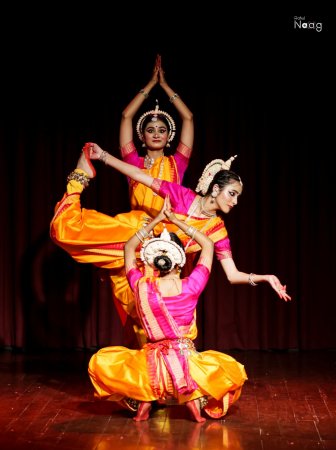 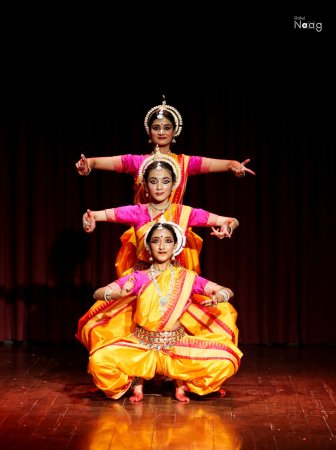 The performance commenced with the traditional invocatory number Mangalacharan, followed by Stayi Nritya that incorporated the typical characteristic movements with the inclusion of the chauka and the varied tribangis with the recitation of 'Ta ha tai, Ta kita tai.' Next was the quintessential pure dance number the Arabhi Pallavi, a choreography of Guru Pankaj Charan Das, performed by six dancers. Banamali Das's composition in Odia "To lagi" featured the mugdha nayika and playful interaction of Radha and Krishna as they dance merrily. Another pure dance number that was presented was the Saveri Pallavi. However, the piece-de-resistance of the Odissi performance was the Surya Astakam performed with vibrant movements while executing the Surya Namaskar and the salutations to the Sun God that illuminates the entire universe, performed quite well by the talented dancers. The two guest performers of the evening were Gayatri Ranbir, daughter and disciple of Guru Durga Charan Ranbir and young talented Kathak dancer Kavita Thakur, disciple of the veteran Pt Munnalal Shukla. Gayatri Ranbir is an accomplished Odissi dancer and has performed in some of the most prestigious festivals in India and abroad. She performed only one Odia composition that revealed the intimate relationship of Radha and Krishna as she vividly recollects the moments she spent with her beloved. Gayatri's expressions were natural and subtle, the movements were elegant and precise, creating a fine impression. 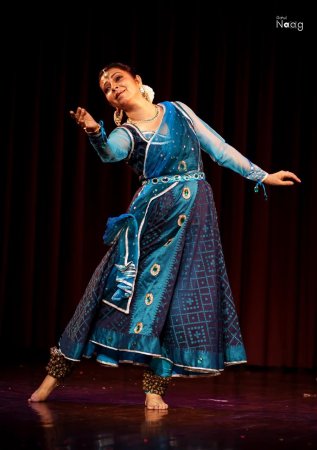 Kavita Thakur Kavita Thakur performed Kathak with complete involvement and expertise but the impact could have been enhanced, as unfortunately she was not provided the foot mike. Kavita commenced with a beautiful Dhrupad that formed a fine synthesis of music and dance, inclusive of some intricate rhythmic movements. To dance to recorded music in Kathak is not easy but Kavita danced with effortless ease and precision. The finale number had a philosophical touch and message as the saint poet says, "Do not be proud of your body as one day the swan will fly away alone in the journey of life" (Ud jayega hansa akela). 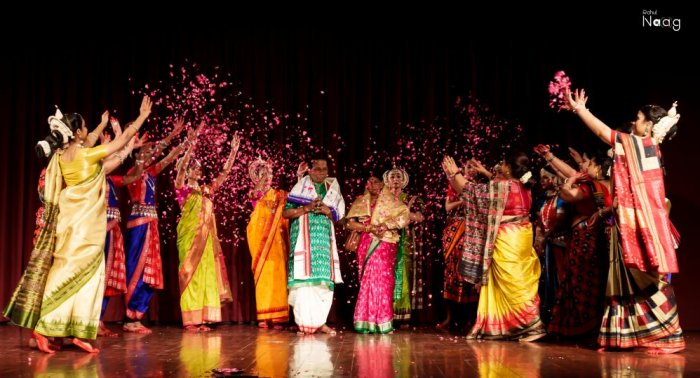 Felicitation On behalf of Vaishali Kala Kendra, Dr Jyothi Shrivastava felicitated Guru Durga Charan Ranbir and social activist Uma Shankar Garg. SAMANVAYA - A SYMPHONY OF GRACE, UNITY AND WOMANHOOD Empowered steps, timeless tunes and unstoppable rhythm, Samanvaya was more than a cultural evening. It was a heartfelt celebration of the pulsating rhythm and the spirit of womanhood. From the spark of an idea to the final bow on stage, the common binding factor of three enterprising women, Megha Nair, Sreeja Jyothish and Bindu Chandran, was the devotion for classical music and dance, hence Samanvaya emerged to provide a platform to different classical and folk dance styles and music on the same platform. Samanvaya was presented by Vibgyor, concept, design and direction by Sreeja Jyothish, celebrating elegant rhythm of women, at the CSOI auditorium, Chanakyapuri, New Delhi on 27th April. 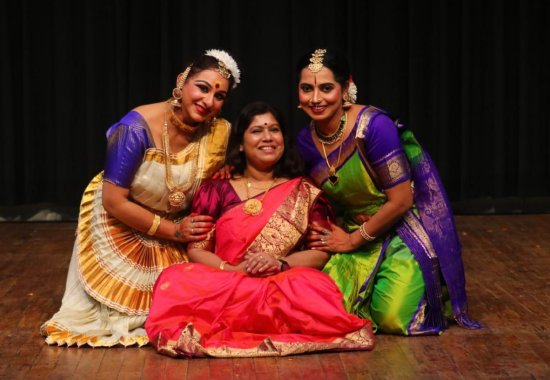 Megha Nair, Bindu Chandran & Sreeja Jyothish Samanvaya featured Mohiniattam by Megha Nair, Bharatanatyam by Sreeja Jyothish, Carnatic vocal by Bindu Chandran, Kathakali by Akash Mallick, Theyyam by Reshmi PC and group. It was a colourful spectacle to behold. The programme commenced with the commendable Carnatic music concert by Dr Bindu Chandran, with Sree Mahaganapathim in Atana ragam and adi talam, Saraswati Nomostute in Saraswati raga, followed with unfolding of the Hindolam ragam in Samagana lolane and the main Kriti of the concert was "Etavunnara" in Kalyani that enhanced the devotional fervour of the audience. Bindu was ably accompanied by Uma Arun on the violin and Vignesh Jayaraman on the mridangam. Dr Bindu is serving as assistant professor at the Faculty of Music and Fine Arts, University of Delhi. Her research doctoral thesis was 'Melodic and rhythmical characteristics of the folk arts of Malabar' and is an established vocalist. Sreeja Jyothish is an accomplished Bharatanatyam exponent and the founder of Shruthi Cultural Group. She was initially trained in Bharatanatyam by Kalamandalam Isha and later under Dr Saroja Vaidyanathan and Rama Vaidyanathan. Sreeja is a qualified lawyer too and is currently working with the Ministry of Information and Broadcasting, Government of India and has served as guest lecturer for Bharatanatyam at the National School of Drama in New Delhi. Based on the 10th chapter of the Bhagavatham, Navarasa Mohana, as the name suggests incorporates the various 'rasas', that is experienced with the change of situations. When Lord Krishna enters Mathura with the intention of defeating the tyrant Kamsa, the reaction of the people and ultimately when the young Krishna overpowers the wicked Kamsa, the different rasas like adbhuta, bhayanaka, raudra and veera are displayed as the scene changes and ultimately it is peace and anandam that is experienced by everyone. Sreeja Jyotish succeeded in the execution with powerful abhinaya, with choreography by Rama Vaidyanathan. 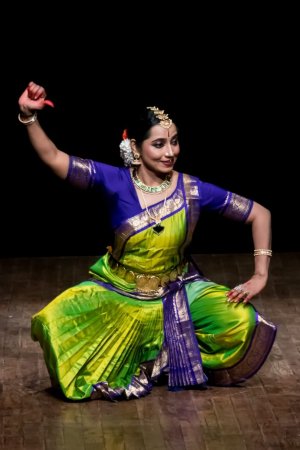 Sreeja Jyothish 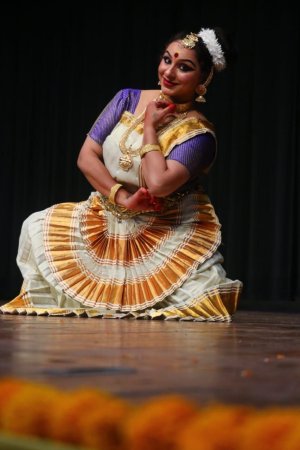 Megha Nair 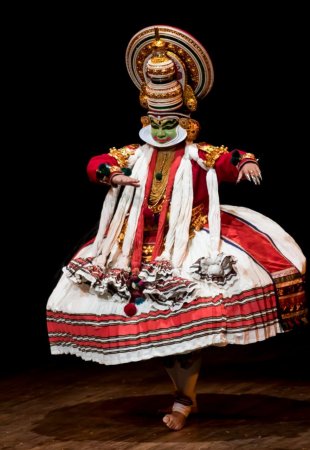 Akash Mallick Akash Mallick is a wonderful dancer who performs the Marga Natya and is the disciple of Guru Piyal Bhattacharya of Kolkata. He was the only male dancer to have performed for this festival. Akash performed "Purappadu" in the Kathakali style. The Purappadu literally means to prepare yourself for the complete performance, hence it is a primary item which is taught to the students after they have completed their preliminary steps and the abhinaya lessons, ready to participate in a complete dance drama presentation with the enaction of various characters, according to the story or episode that is decided to take centre stage of the performance. Akash did justice to his brief performance. The only folk presentation of the evening was the Theyyam. Theyyam is known for its colourful make up and elaborate head gear which is differentiated according to the God or Goddess that is incorporated. Theyyam is ritualistic in nature, associated with the rituals in the temple and performed accordingly. This Theyyam dance was dedicated to Muchilikot Bhagawathi, as she rises from the fire of Shri Shakthi - the Mother, the warrior, the creator of life, hence the complete process of prayers to the Goddess, her appearance and her power to give life and vital energy to all those who become her devotees were demonstrated with vivacious intensity by Reshmi PC and her talented group of dancers. 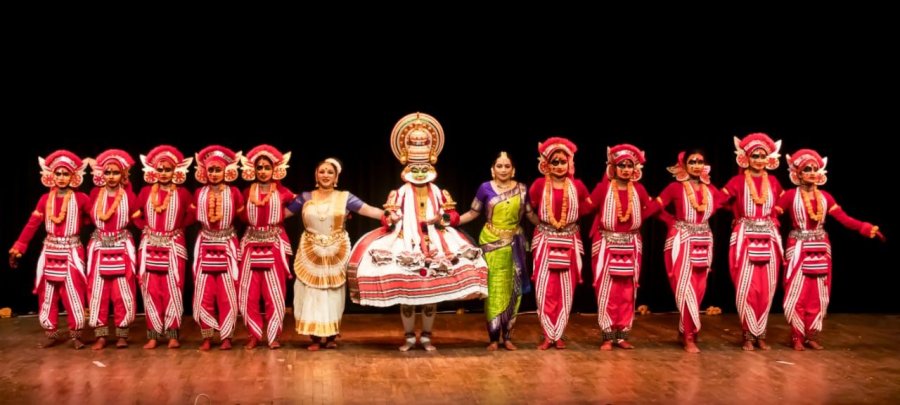 Finale Earlier to the grand finale, there was a trigalbandi, wherein three forms, Bharatanatyam by Sreeja, Mohiniattam by Megha and Kathakali by Akash, appeared together to converse with rhythmic movements which was quite interesting. Furthermore, the Theyyam dancers too joined them with the rhythmic recitation of 'Dim Dhat Thai, Taka Dhim Thom" as the spectators clapped and joined the rhythmic atmosphere that was vibrating and throbbing with the underlining message that life is a dance, and we must all dance together to enhance peace and harmony in our lives. NRITYA MANJARI The Sarat Smruti festival known as Nritya Manjari was organised by Geeta Mahalik's Upasana Academy, featuring Geeta Mahalik and her disciples in an Odissi performance, Bharatanatyam performance by Rama Vaidyanathan and a contemporary dance drama performance by Krishan Kumar Sharma and troupe. On this occasion, two veteran performers, Odissi exponent Madhavi Mudgal and Bharatanatyam dancer Geeta Chandran were felicitated with the Upasana Samman for their outstanding contribution towards the propagation and enrichment of classical dances. The event was held at the Stein auditorium, India Habitat Centre, New Delhi on 30th April, dedicated to the memory of Sarat Mahalik and Guru Mayadhar Raut, supported by the Ministry of Culture, Government of India. 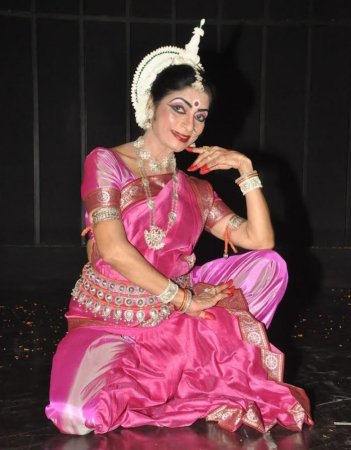 Geeta Mahalik The programme commenced with the Odissi performance by Guru Geeta Mahalik and her team of dancers with the incorporation of Krishna Stuti in praise of Lord Krishna, followed with Banmali Das's Odia composition Yamuna Prasang - "Kali jaha kale sakhi" - in which Radha is disturbed as she sees the dalliance of Krishna with the Gopis on the banks of the river Yamuna and informs her friend about her plight and misery. In another performance of Krishna Leela, a Surdas composition, in which the varied pranks of Krishna are displayed, inclusive of Krishna's encounter with the serpent and his ultimate victory over it was well dramatized by Sushant Maharana as Krishna. Other dancers included Sangita Mohanty, Twinkle Soni, Madhuri Bhowmick and Oshika Jain. It was a pleasure to watch Geeta Mahalik dance with elegance and natural expressions. 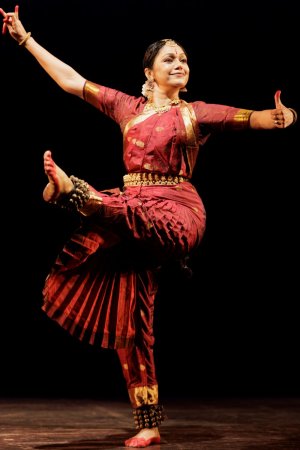 Rama Vaidyanathan Every time I watch Rama Vaidyanathan perform, it's so refreshing and elevating, as she has some new inspiring theme to offer. It's not just the striking expressions, vibrant and powerful movements or the choreography but the theme was also absorbing with a philosophical message that concerns everyone and stirs the soul of the spectators. Based on the philosophy of Guru Nanak, founder of Sikhism and an extract from Guru Bani, Dasha Avastha, interprets the ten stages in the life of a human being, the yearning for milk after the infant is born, seeking attention from parents, the craze for toys, seeking attention from the peer group, the appetite for tasty food, wanting sensual pleasures, the madness for wealth and property, no peace and restlessness, old age and ultimately, the fear of death. Rama succeeded in taking the audience through the ten stages with complete involvement, revealing the message that the ultimate happiness lies when you surrender yourself to the Almighty, devoid of all worldly attachments. 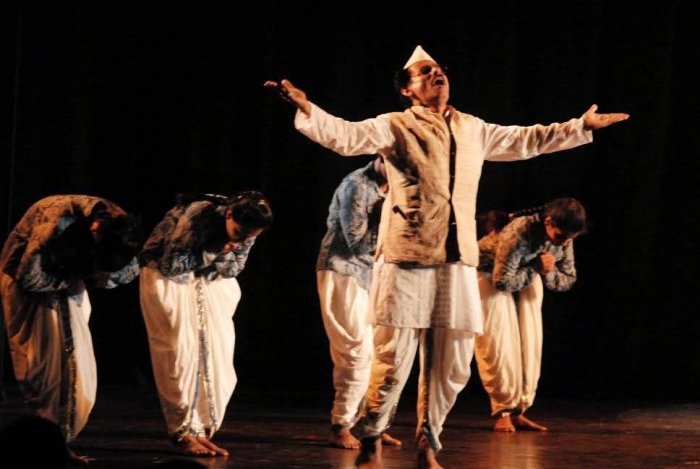 Krishan Kumar Sharma and group The last performance of the evening was the contemporary dance drama performed by Guru Krishan Kumar Sharma and his group of talented actors and dancers in the dramatization of a political satire with a touch of comedy. The scene was hilarious when the Neta or leader is about to occupy the seat and somebody topples it down and he has a great fall, revealing the message of power play where in order to secure power, people are prepared to stoop to or compromise to any extent. Krishan Kumar is inspired by the Uday Shankar style of dancing and believes that entertainment should cater to the problems confronted by the common man, thereby reaching out to a larger section of the society. 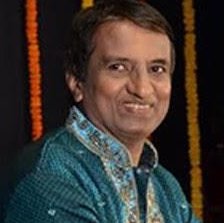 Vijay Shankar is a Kuchipudi and Kathakali exponent, teacher, bilingual journalist, arts critic and actor. |